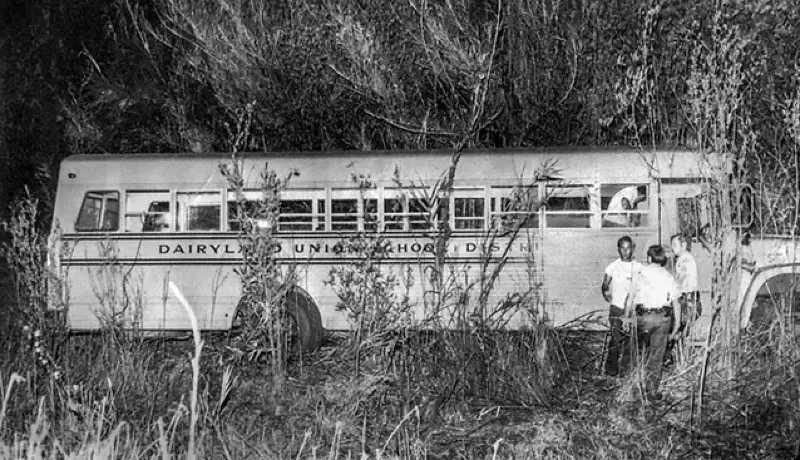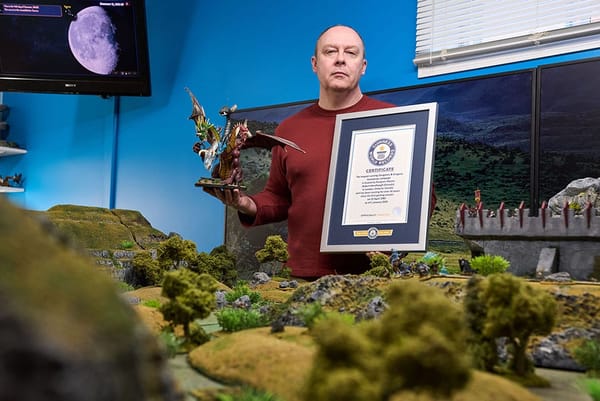In 1976 a bus-load of children were kidnapped and buried alive

From the City of Chowchilla: "On July 15, 1976, a busload of children aged 5 to 14 and their school bus driver, Ed Ray were abducted on a country road in Madera County at about 4 p.m. on their way back from a swim outing. The bus was later found empty, covered with bamboo and brush in a drainage ditch west of town. The victims, 19 girls and seven boys, were driven around for 11 hours in two vans before being entombed in a moving van and buried in a Livermore rock quarry. After 16 hours underground in an 8-foot by 16-foot space, two of the older children and Ray were able to escape after digging themselves out with only their hands, cutting themselves along the way. Investigators dug up the van and learned it had been buried in the quarry in November 1975. The son of the quarry's owner, Fred Newhall Woods IV, 24, was later arrested, along with his two friends, James Schoenfeld, 24, and his brother, Richard Schoenfeld, 22."
Why are there so many different human blood types? Scientists aren't quite sure

From The Smithsonian: "When you get a blood transfusion, doctors have to make sure a donor’s blood type is compatible with the recipient’s blood, otherwise the recipient can die. The ABO blood group, as the blood types are collectively known, are ancient. Humans and all other apes share this trait, inheriting these blood types from a common ancestor at least 20 million years ago and maybe even earlier. But why humans and apes have these blood types is still a scientific mystery. The “type” actually refers to the presence of a particular type of antigen sticking up from the surface of a red blood cell. The human body naturally makes antibodies that will attack certain types of red-blood-cell antigens. For example, people with type A blood make antibodies that attack B antigens; people with type B blood make antibodies that attack A antigens. So, type A people can’t donate their blood to type B people and vice versa."
Why no one wanted to be invited to one of Stalin's dinner parties

From Le Temps D'Un Biere: "For the paranoid, blood-thirsty mustached dictator Joseph Stalin, drink served both as entertainment and internal repression. In the Politburo (the main soviet decision-making body), Stalin’s comrades lived under the daily fear of being shot. However, there is another thing that his collaborators dreaded intensely than being arrested: being invited to a party at Stalin’s. After the Second World War, as the health of the Iron Man began to decline, Stalin distanced himself from the center of power and grew ever more reclusive, spending more and more time in his small residence in the suburbs of Moscow. Dinners turned into evenings, evenings turned to parties, and parties turned into catastrophes. This was not the usual ordinary dinner at a slightly eccentric uncle’s. Khrushchev, a regular at his soirées, would say in his memoirs: “There was only one person who had fun during his parties: Stalin.”
Editor's note: If you like this newsletter, please share it with someone else. And if you really like it, perhaps you could subscribe, or contribute something via my Patreon. Thanks for being a reader!
An Illinois school principal decided to build a 30-foot tower for his goats to climb

From Atlas Obscura: "Saanen goats are a Swiss breed known for their tendency to climb the tallest structure in their immediate surroundings, so one caring couple in Illinois built a literal tower to put their flock at ease. The Tower of Baa-Goat is located on a sprawling property belonging to husband-and-wife Dave and Marcia Johnson. The 30-foot tall structure was built with 276 steps wrapping around the frame, which allows the Johnson’s goats to reach their respective “apartments.” Dave was flipping through an issue of Decanter magazine in the mid-1990s when he was struck by an image of a winery in South Africa, which featured a tower with spiral steps upon which a flock of goats ascended and descended. It was the second tower of its kind ever built, the first being erected in the 19th century at a winery in Portugal. Dave decided he would build the third."
Inside a safe on a submarine whose location is unknown is the letter of last resort

From Terra Nullius: "Somewhere out in the North Atlantic, every hour of the day, every day of the year, a lone submarine glides through the ocean with no real destination. Since 1969, one of the four boats of the UK's Continuous At-Sea Submarine Deterrent has always been on patrol. Its location is known to only a handful, even many of her crew will have no idea where they are. While many Royal Navy captains hold responsibility for their crew, Trident submarine commanders also bear a far more macabre role: the duty to play Britain's final political and diplomatic hand possible. Within the bowels of each boat lays two safes, an outer and an inner, and within that inner safe sits the letter of last resort. One of the first tasks of the Cabinet Secretary on the appointment by the Queen of a new prime minister, is to have the new leader write that very letter."
How Cardinal Richelieu invented the butter knife in the 17th century

From Science Lens: "The story goes that Cardinal Richelieu got irritated by the brutish behaviour of men at the dining tables of the time, stabbing their daggers (which doubled as table cutlery) into chunks of meat and other food, or into the table, for that matter, if they needed their hands free. And even worse was their despicable habit of using the sharp daggers to pick their teeth at the end of the meal. To put an end to this behaviour, he ordered his kitchen staff to file off the sharp points of all the house knifes. The idea caught on, and it wasn’t long before this new style of rounded table knife became a trendy dinner accessory in upper-class French households. In 1669, King Louis XIV of France banned pointed knives – at the table and as weapons – and this further cemented the position of the round-ended table knife as preferred form of cutlery."
Here's the kind of view you are likely to get at the top of Mount Everest
These videos of the queue up Everest and the aftermath of the cornice collapse that killed a couple of people...
— tern (@1goodtern) May 24, 2024
There's something about this that sums up so much of what's wrong with the world.
😮 pic.twitter.com/S2qv1oBAOG
Acknowledgements: I find a lot of these links myself, but I also get some from other newsletters that I rely on as "serendipity engines," such as The Morning News from Rosecrans Baldwin and Andrew Womack, Jodi Ettenberg's Curious About Everything, Dan Lewis's Now I Know, Robert Cottrell and Caroline Crampton's The Browser, Clive Thompson's Linkfest, Noah Brier and Colin Nagy's Why Is This Interesting, Maria Popova's The Marginalian, Sheehan Quirke AKA The Cultural Tutor, the Smithsonian magazine, and JSTOR Daily. If you come across something interesting that you think should be included here, please feel free to email me at mathew @ mathewingram dot com



